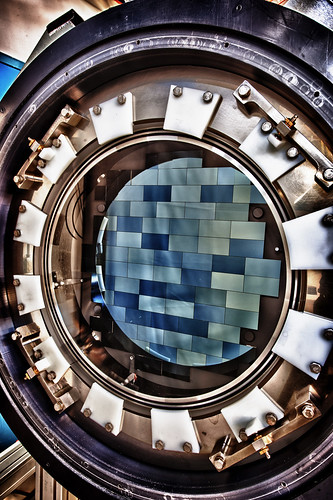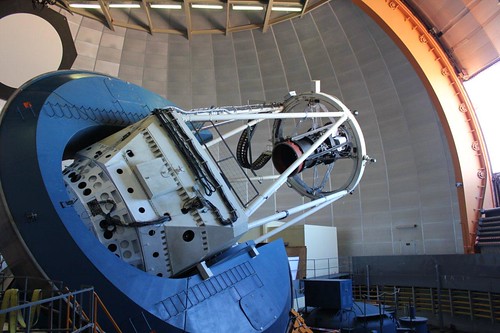Dark Energy Camera

|
| The 570-megapixel CCD array of the DECam. In use, this sits behind large corrector lenses and the interchangeable filter mechanism image by Fermilab (Image rights) |
The Dark Energy Camera or DECam created at Fermilab became the biggest digital camera in the world[1] when it entered service in 2012[2] at the 4-meter Blanco telescope of the Cerro Tololo Inter-American Observatory in Chile.
The camera was designed as the research instrument for the Dark Energy Survey, which uses repeated wide-field astronomical observations to shed light on fundamental questions in cosmology.
As this camera was designed for observations of highly-redshifted light, it uses special CCD chips, developed by the Lawrence Berkeley National Laboratory and manufactured by Dalsa. These have a large 15µm-square pixel size, and an extra-deep silicon substrate to maximize photon-capture efficiency at far red wavelengths.
The primary imaging area is a mosaic of 62 CCDs, each of 2048 x 4096 pixels, for 520 megapixels in total. At the edges of the focal plane, twelve additional CCDs of 2048 pixels square are dedicated to focus calibration and guide-star tracking. These extra 50 megapixels are included in the description of the DECam as a "570 megapixel camera" (as typically quoted in publicity materials). The CCD array is cooled to -100°C to reduce thermal noise, held within a vacuum chamber to prevent condensation from forming. Each exposure results in a file size of around a gigabyte, and takes 17 seconds to read out from the sensor[3].
Starlight reflected off the 4-meter-diameter mirror surface passes through corrector optics consisting of five lenses; the largest of these is almost a meter in diameter and weighs 173 kg (380 lbs)[3]. Combined, the whole optical system has an effective focal length of about 11,600 mm and works at f/2.9. With the corrector-optics assembly and filter changer, the camera's complete weight is 4 or 5 tons[4]. The complete camera is somewhat larger than a telephone booth[5].
After checkout and calibration were completed, the Dark Energy Survey observation campaign officially began on August 31, 2013[6]. The full survey project will take five years to complete.
The title of "world's largest digital camera" may eventually pass to the LSST Camera, a somewhat similar design with a planned 3,200 megapixel resolution.
| ||
|
Notes
- ↑ Another claimant to this title is the Pan-STARRS (archived) 1,400 megapixel camera GPC1; but it is handicapped by many defective sensor chips as well as wide gaps between them, totaling nearly one quarter of the image plane in any single exposure (as discussed here). In all-sky survey work, these deficiencies can be overcome by stacking numerous individual exposures offset from one another.
- ↑ "World’s most powerful digital camera opens eye, records first images in hunt for dark energy" from Fermilab, the Fermi National Accelerator Laboratory.
- ↑ 3.0 3.1 "Additional Information about DECam" (archived) from The Dark Energy Survey
- ↑ "New Camera Sheds Light on Dark Energy" (archived) from the US Department of Energy
- ↑ A photo of the camera and two technicians illustrates its size.
- ↑ "Dark Energy Survey begins five-year mission to map southern sky in tremendous detail" from Fermilab

